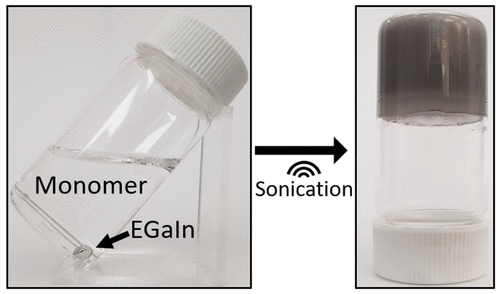当前位置:
X-MOL 学术
›
ACS Macro Lett.
›
论文详情
Our official English website, www.x-mol.net, welcomes your feedback! (Note: you will need to create a separate account there.)
Liquid Metal Nanoparticles as Initiators for Radical Polymerization of Vinyl Monomers
ACS Macro Letters ( IF 5.8 ) Pub Date : 2019-11-01 , DOI: 10.1021/acsmacrolett.9b00783 Jinwoo Ma 1, 2 , Yiliang Lin 1 , Yong-Woo Kim 2 , Yeongun Ko 1 , Jongbeom Kim 2 , Kyu Hwan Oh 2, 3 , Jeong-Yun Sun 2, 3 , Christopher B Gorman 4 , Maxim A Voinov 4 , Alex I Smirnov 4 , Jan Genzer 1 , Michael D Dickey 1
ACS Macro Letters ( IF 5.8 ) Pub Date : 2019-11-01 , DOI: 10.1021/acsmacrolett.9b00783 Jinwoo Ma 1, 2 , Yiliang Lin 1 , Yong-Woo Kim 2 , Yeongun Ko 1 , Jongbeom Kim 2 , Kyu Hwan Oh 2, 3 , Jeong-Yun Sun 2, 3 , Christopher B Gorman 4 , Maxim A Voinov 4 , Alex I Smirnov 4 , Jan Genzer 1 , Michael D Dickey 1
Affiliation

|
Sonication of gallium or gallium-based liquid metals in an aqueous solution of vinyl monomers leads to rapid free radical polymerization (FRP), without the need for conventional molecular initiators. Under ambient conditions, a passivating native oxide separates these metals from solution and renders the metal effectively inert. However, sonication generates liquid metal nanoparticles (LMNPs) of ∼100 nm diameter and thereby increases the surface area of the metal. The exposed metal initiates polymerization, which proceeds via a FRP mechanism and yields high molecular weight polymers that can form physical gels. Spin trapping EPR reveals the generation of free radicals. Time-of-flight secondary ion mass spectrometry measurements confirm direct polymer bonding to gallium, verifying the formation of surface-anchored polymer grafts. The grafted polymers can modify the interfacial properties, that is, the preference of the metal particles to disperse in aqueous versus organic phases. The polymer can also be degrafted and isolated from the particles using strong acid or base. The concept of physically disrupting passivated metal surfaces offers new routes for surface-initiated polymerization and has implications for surface modification, reduction reactions, and fabrication of mechanically responsive materials.
中文翻译:

液态金属纳米粒子作为乙烯基单体自由基聚合的引发剂
在乙烯基单体的水溶液中对镓或镓基液态金属进行超声处理会导致快速自由基聚合 (FRP),而无需使用传统的分子引发剂。在环境条件下,钝化的天然氧化物将这些金属从溶液中分离出来,并使金属有效地惰性化。然而,超声处理会产生直径约 100 nm 的液态金属纳米颗粒 (LMNP),从而增加金属的表面积。暴露的金属引发聚合反应,聚合反应通过 FRP 机制进行并产生可形成物理凝胶的高分子量聚合物。自旋捕获 EPR 揭示了自由基的产生。飞行时间二次离子质谱测量证实了聚合物与镓的直接结合,验证了表面锚定聚合物接枝的形成。接枝聚合物可以改变界面性质,即金属颗粒更倾向于分散在水相中而不是有机相中。也可以使用强酸或强碱使聚合物脱枝并与颗粒分离。物理破坏钝化金属表面的概念为表面引发聚合提供了新途径,并对表面改性、还原反应和机械响应材料的制造产生了影响。
更新日期:2019-11-01
中文翻译:

液态金属纳米粒子作为乙烯基单体自由基聚合的引发剂
在乙烯基单体的水溶液中对镓或镓基液态金属进行超声处理会导致快速自由基聚合 (FRP),而无需使用传统的分子引发剂。在环境条件下,钝化的天然氧化物将这些金属从溶液中分离出来,并使金属有效地惰性化。然而,超声处理会产生直径约 100 nm 的液态金属纳米颗粒 (LMNP),从而增加金属的表面积。暴露的金属引发聚合反应,聚合反应通过 FRP 机制进行并产生可形成物理凝胶的高分子量聚合物。自旋捕获 EPR 揭示了自由基的产生。飞行时间二次离子质谱测量证实了聚合物与镓的直接结合,验证了表面锚定聚合物接枝的形成。接枝聚合物可以改变界面性质,即金属颗粒更倾向于分散在水相中而不是有机相中。也可以使用强酸或强碱使聚合物脱枝并与颗粒分离。物理破坏钝化金属表面的概念为表面引发聚合提供了新途径,并对表面改性、还原反应和机械响应材料的制造产生了影响。



























 京公网安备 11010802027423号
京公网安备 11010802027423号